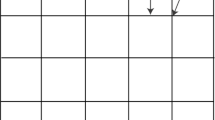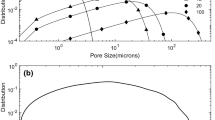Abstract
Various processes such as heterogeneous reactions or biofilm growth alter a porous medium’s underlying geometric structure. This significantly affects its hydrodynamic parameters, in particular the medium’s effective permeability. An accurate, quantitative description of the permeability is, however, essential for predictive flow and transport modeling. Well-established relations such as the Kozeny–Carman equation or power law approaches including fitting parameters relate the porous medium’s porosity to a scalar permeability coefficient. Opposed to this, upscaling methods directly enable calculating the full, potentially anisotropic, permeability tensor. As input, only the geometric information in terms of a representative elementary volume is needed. To compute the porosity–permeability relations, supplementary cell problems must be solved numerically on this volume and their solutions must be integrated. We apply this approach to provide easy-to-use quantitative porosity–permeability relations that are based on representative single grain, platy, blocky, prismatic soil structures, porous networks, and real geometries obtained from CT-data. As a discretization method, we use discontinuous Galerkin method on structured grids. To make the relations explicit, interpolation of the obtained data is used. We compare the outcome with the well-established relations and investigate the ranges of the validity. From our investigations, we conclude whether Kozeny–Carman-type or power law-type porosity–permeability relations are more reasonable for various prototypic representative elementary volumes. Finally, we investigate the impact of a microporous solid matrix onto the permeability.














Similar content being viewed by others
Notes
©2017 The MathWorks, Inc. MATLAB and Simulink are registered trademarks of The MathWorks, Inc. See mathworks.com/trademarks for a list of additional trademarks. Other products or brand names may be trademarks or registered trademarks of their respective holders.
References
Ahmadi, M.M., Mohammadi, S., Hayati, A.N.: Analytical derivation of tortuosity and permeability of monosized spheres: a volume averaging approach. Phys. Rev. E 83, 8 (2011). https://doi.org/10.1103/PhysRevE.83.026312
Allaire, G.: Homogenization and two-scale convergence. SIAM J. Math. Anal. 23(6), 1482–1518 (1992)
Allaire, G., Brizzi, R., Dufrêche, J.F., Mikelić, A., Piatnitski, A.: Ion transport in porous media: derivation of the macroscopic equations using upscaling and properties of the effective coefficients. Comput. Geosci. 17(3), 479–495 (2013). https://doi.org/10.1007/s10596-013-9342-6
Alreshedan, F., Kantzas, A.: Investigation of permeability, formation factor, and porosity relationships for mesaverde tight gas sandstones using random network models. J. Pet. Explor. Product. Technol. 6(3), 545–554 (2016). https://doi.org/10.1007/s13202-015-0202-x
Arbogast, T., Lehr, H.L.: Homogenization of a Darcy–Stokes system modeling vuggy porous media. Comput. Geosci. 10(3), 291–302 (2006). https://doi.org/10.1007/s10596-006-9024-8
Bear, J.: Dynamics of Fluids in Porous Media. Dover Publications, New York (1972)
Beavers, G., Joseph, D.: Boundary conditions at a naturally permeable wall. J. Fluid Mech. 30, 197–207 (1967)
Bensoussan, A., Lions, J.L., Papanicolau, G.: Asymptotic Analysis of Periodic Structures. North-Holland, Amsterdam (1978)
Berg, C.F.: Permeability description by characteristic length, tortuosity, constriction and porosity. Transp. Porous Media 103(3), 381–400 (2014). https://doi.org/10.1007/s11242-014-0307-6
Bernabé, Y., Bruderer-Weng, C., Maineult, A.: Permeability fluctuations in heterogeneous networks with different dimensionality and topology. J. Geophys. Res. Solid Earth 108(B7), 1 (2003). https://doi.org/10.1029/2002JB002326
Carman, P.: Fluid flow through a granular bed. Trans. Inst. Chem. Eng. 15, 150–167 (1937)
Carman, P.: Permeability of saturated sands, soils and clays. J. Agric. Sci. 29, 263–273 (1939)
Carrier, W.D.: Goodbye, Hazen; hello, Kozeny–Carman. J. Geotech. Geoenviron. Eng. 129(11), 1054–1056 (2003). https://doi.org/10.1061/(ASCE)1090-0241
Chamsri, K., Bennethum, L.S.: Permeability of fluid flow through a periodic array of cylinders. Appl. Math. Model. 39(1), 244–254 (2015). https://doi.org/10.1016/j.apm.2014.05.024
Chapuis, R.P.: Predicting the saturated hydraulic conductivity of soils: a review. Bull. Eng. Geol. Environ. 71(3), 401–434 (2012). https://doi.org/10.1007/s10064-012-0418-7
Chapuis, R.P., Aubertin, M.: Predicting the coefficient of permeability of soils using the Kozeny–Carman equation. Can. Geotech. J. 40(3), 616–628 (2003)
Cockburn, B., Kanschat, G., Schötzau, D., Schwab, C.: Local discontinuous Galerkin methods for the Stokes system. SIAM J. Numer. Anal. 40(1), 319–343 (2002). https://doi.org/10.1137/S0036142900380121
Costa, A.: Permeability–porosity relationship: a reexamination of the Kozeny–Carman equation based on a fractal pore-space geometry assumption. Geophys. Res. Lett. 33(2), 1–5 (2006)
Crolet, J.M.: Computational Methods for Flow and Transport in Porous Media. Springer, Dordrecht (2000)
Darcy, H.: Les fontaines publiques de la ville de Dijon. Exposition et application des principes à suivre et des formules à employer dans les questions de distribution d’eau: ouvrage terminé par un appendice relatif aux fournitures d’eau de plusieurs villes au filtrage des eaux et à la fabrication des tuyaux de fonte, de plomb, de tole et de bitume. Dalmont, Kraljevica (1856)
Duda, A., Koza, Z., Matyka, M.: Hydraulic tortuosity in arbitrary porous media flow. Phys. Rev. E 84, 8 (2011). https://doi.org/10.1103/PhysRevE.84.036319
Dvorkin, J.: Kozeny–Carman equation revisited. Accessed 15 Dec 2016
Galindo-Rosales, F.J., Campo-Deaño, L., Pinho, F.T., van Bokhorst, E., Hamersma, P.J., Oliveira, M.S.N., Alves, M.A.: Microfluidic systems for the analysis of viscoelastic fluid flow phenomena in porous media. Microfluid. Nanofluid. 12(1), 485–498 (2012). https://doi.org/10.1007/s10404-011-0890-6
Ghanbarian, B., Hunt, A.G., Ewing, R.P., Sahimi, M.: Tortuosity in porous media: a critical review. Soil Sci. Soc. Am. J. 77, 1461–1477 (2013). https://doi.org/10.2136/sssaj2012.0435
Griebel, M., Klitz, M.: Homogenization and numerical simulation of flow in geometries with textile microstructures. Multiscale Model. Simul. 8(4), 1439–1460 (2010). https://doi.org/10.1137/09077059X
Hallett, P., Karim, K., Bengough, A., Otten, W.: Biophysics of the vadose zone: from reality to model systems and back again. Vadose Zone J. 12(4), 17 (2013). https://doi.org/10.2136/vzj2013.05.0090
Hommel, J., Coltman, E., Class, H.: Porosity–permeability relations for evolving pore space: a review with a focus on (bio-)geochemically altered porous media. Transp. Porous Media 124(2), 589–629 (2018). https://doi.org/10.1007/s11242-018-1086-2
Hornung, U.: Homogenization and Porous Media. Springer, Berlin (1997)
Huang, X., Yue, W., Liu, D., Yue, J., Li, J., Sun, D., Yang, M., Wang, Z.: Monitoring the intracellular calcium response to a dynamic hypertonic environment. Sci. Rep. 6, 8 (2016). https://doi.org/10.1038/srep23591
Huang, Z., Yao, J., Wang, C.: Numerical calculation of equivalent permeability tensor for fractured vuggy porous media based on homogenization theory. Commun. Comput. Phys. 9(1), 180–204 (2011)
Kozeny, J.: Über kapillare Leitung des Wassers im Boden. Sitzungsber Akad. Wiss. Wien 136(2a), 271–306 (2004)
Li, X., Huang, H., Meakin, P.: A three-dimensional level set simulation of coupled reactive transport and precipitation/dissolution. Int. J. Heat Mass Transf. 53, 2908–2923 (2010). https://doi.org/10.1016/j.ijheatmasstransfer.2010.01.044
Menke, H., Bijeljic, B., Blunt, M.: Dynamic reservoir-condition microtomography of reactive transport in complex carbonates: effect of initial pore structure and initial brine ph. Geochim. Cosmochim. Acta 204, 267–285 (2017). https://doi.org/10.1016/j.gca.2017.01.053
Nguetseng, G.: A general convergence result for a functional related to the theory of homogenization. SIAM J. Math. Anal. 20(3), 608–623 (1989). https://doi.org/10.1137/0520043
Nimmo, J.: Porosity and pore size distribution. Encycl. Soils Environ. 3, 295–303 (2004)
Ozgumus, T., Mobedi, M., Ozkol, U.: Determination of Kozeny constant based on porosity and pore to throat size ratio in porous medium with rectangular rods. Eng. Appl. Comput. Fluid Mech. 8(2), 308–318 (2014). https://doi.org/10.1080/19942060.2014.11015516
Peszynska, M., Trykozko, A., Iltis, G., Schlueter, S., Wildenschild, D.: Biofilm growth in porous media: experiments, computational modeling at the porescale, and upscaling (pore scale modeling and experiments). Adv. Water Resour. 95, 288–301 (2016). https://doi.org/10.1016/j.advwatres.2015.07.008
Pinela, J., Kruz, S., Heitor Reis, A., Miguel, A., Aydin, M.: Permeability–porosity relationship assessment by 2D numerical simulations. In: Proceedings of the 16th International Symposium on Transport Phenomena (2005)
Pisani, L.: Simple expression for the tortuosity of porous media. Transp. Porous Media 88(2), 193–203 (2011). https://doi.org/10.1007/s11242-011-9734-9
Quintard, M.: Diffusion in isotropic and anisotropic porous systems: three-dimensional calculations. Transp. Porous Media 11(2), 187–199 (1993). https://doi.org/10.1007/BF01059634
Randall, C.L., Kalinin, Y.V., Jamal, M., Manohar, T., Gracias, D.H.: Three-dimensional microwell arrays for cell culture. Lab Chip 11(1), 127–131 (2011). https://doi.org/10.1039/c0lc00368a
Ray, N., van Noorden, T., Frank, F., Knabner, P.: Multiscale modeling of colloid and fluid dynamics in porous media including an evolving microstructure. Transp. Porous Media 95(3), 669–696 (2012). https://doi.org/10.1007/s11242-012-0068-z
Ray, N., Rupp, A., Schulz, R., Knabner, P.: Old and new approaches predicting the diffusion in porous media. Transp. Porous Media 124(3), 803–824 (2018). https://doi.org/10.1007/s11242-018-1099-x
Reuter, B., Rupp, A., Aizinger, V., Frank, F., Knabner, P.: Festung: a Matlab/GNU Octave toolbox for the discontinuous Galerkin method. Part IV: generic problem framework and model-coupling interface (2018)
Reuter, B., Rupp, A., Aizinger, V., Knabner, P.: Discontinuous Galerkin method for coupling hydrostatic free surface flows to saturated subsurface systems. Comput. Math. Appl. 77, 19 (2019). https://doi.org/10.1016/j.camwa.2018.12.020
Rupp, A., Knabner, P.: Convergence order estimates of the local discontinuous Galerkin method for instationary Darcy flow. Numer. Methods Partial Differ. Equ. 33(4), 1374–1394 (2017). https://doi.org/10.1002/num.22150
Rupp, A., Knabner, P., Dawson, C.: A local discontinuous Galerkin scheme for Darcy flow with internal jumps. Comput. Geosci. 22(4), 1149–1159 (2018). https://doi.org/10.1007/s10596-018-9743-7
Scherer, G.W., Valenza, J.J., Simmons, G.: New methods to measure liquid permeability in porous materials (cementitious materials as model porous media: nanostructure and transport processes). Cement Concr. Res. 37(3), 386–397 (2007). https://doi.org/10.1016/j.cemconres.2006.09.020
Shen, L., Chen, Z.: Critical review of the impact of tortuosity on diffusion. Chem. Eng. Sci. 62(14), 3748–3755 (2004)
Smith, M.M., Sholokhova, Y., Hao, Y., Carroll, S.A.: CO\(_2\)-induced dissolution of low permeability carbonates. Part I: characterization and experiments. Adv. Water Resour. 62, 370–387 (2013). https://doi.org/10.1016/j.advwatres.2013.09.008
Sobieski, W., Zhang, Q.: Sensitivity analysis of Kozeny–Carman and Ergun equations. Technol. Sci. 17(3), 235–248 (2014)
Sullivan, R.R., Hertel, K.R.: The permeability methods for determining specific surface of fibers and powders. Adv. Colloid Sci. 1, 37–80 (1942)
Szymkiewicz, A.: Modelling water flow in unsaturated porous media: accounting for nonlinear permeability and material heterogeneity. Springer, Berlin (2012)
Troeh, F.R., Jabro, J.D., Kirkham, D.: Gaseous diffusion equations for porous materials. Geoderma 27(3), 239–253 (1982). https://doi.org/10.1016/0016-7061(82)90033-7
Valdes-Parada, F., Ochoa-Tapia, J., Alvarez-Ramirez, J.: Validity of the permeability Carman–Kozeny equation: a volume averaging approach. Franc. J. Valdes Parada 388, 789 (2009). https://doi.org/10.1016/j.physa.2008.11.024
van Noorden, T.: Crystal precipitation and dissolution in a porous medium: effective equations and numerical experiments. Multiscale Model. Simul. 7, 1220–1236 (2009)
Wang, Y., Sun, S.: Direct calculation of permeability by high-accurate finite difference and numerical integration methods. Commun. Comput. Phys. 20(2), 405–440 (2016). https://doi.org/10.4208/cicp.210815.240316a
Whitaker, S.: The Method of Volume Averaging. Springer, Berlin (1999)
Wieners, C.: Distributed point objects. A new concept for parallel finite elements. In: T. Barth, M. Griebel, D. Keyes, R. Nieminen, D. Roose, T. Schlick, R. Kornhuber, R. Hoppe, J. Périaux, O. Pironneau, O. Widlund, J. Xu (eds.) Domain Decomposition Methods in Science and Engineering, Lecture Notes in Computational Science and Engineering, vol. 40, pp. 175–182. Springer, Berlin (2005). https://doi.org/10.1007/3540268251_14
Yang, D., Wang, W., Chen, W., Tan, X., Wang, L.: Revisiting the methods for gas permeability measurement in tight porous medium. J. Rock Mech. Geotech. Eng. 11(2), 263–276 (2019). https://doi.org/10.1016/j.jrmge.2018.08.012
Yazdchi, K., Srivastava, S., Luding, S.: On the validity of the Carman–Kozeny equation in random fibrous media. In: E. Onate, D. Owen (eds.) PARTICLES 2011, pp. 1–10. ECCOMAS (2011)
Acknowledgements
This research was kindly supported by the DFG RU 2179 “MAD Soil-Microaggregates: Formation and turnover of the structural building blocks of soils.” We acknowledge the group of Stephan Peth, University of Kassel, Germany, who provided the real 3D scan data.
Author information
Authors and Affiliations
Corresponding author
Additional information
Publisher's Note
Springer Nature remains neutral with regard to jurisdictional claims in published maps and institutional affiliations.
Rights and permissions
About this article
Cite this article
Schulz, R., Ray, N., Zech, S. et al. Beyond Kozeny–Carman: Predicting the Permeability in Porous Media. Transp Porous Med 130, 487–512 (2019). https://doi.org/10.1007/s11242-019-01321-y
Received:
Accepted:
Published:
Issue Date:
DOI: https://doi.org/10.1007/s11242-019-01321-y




